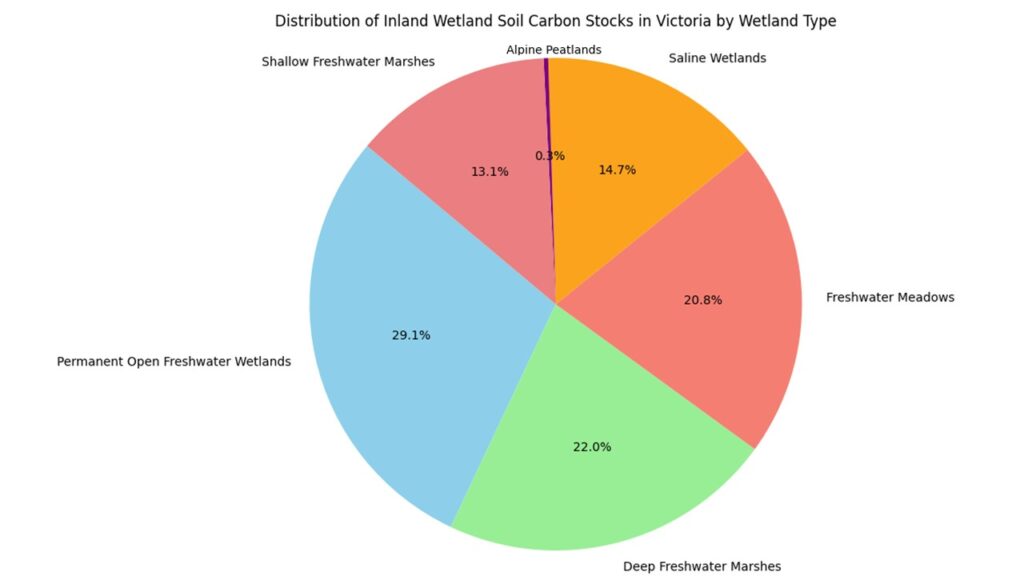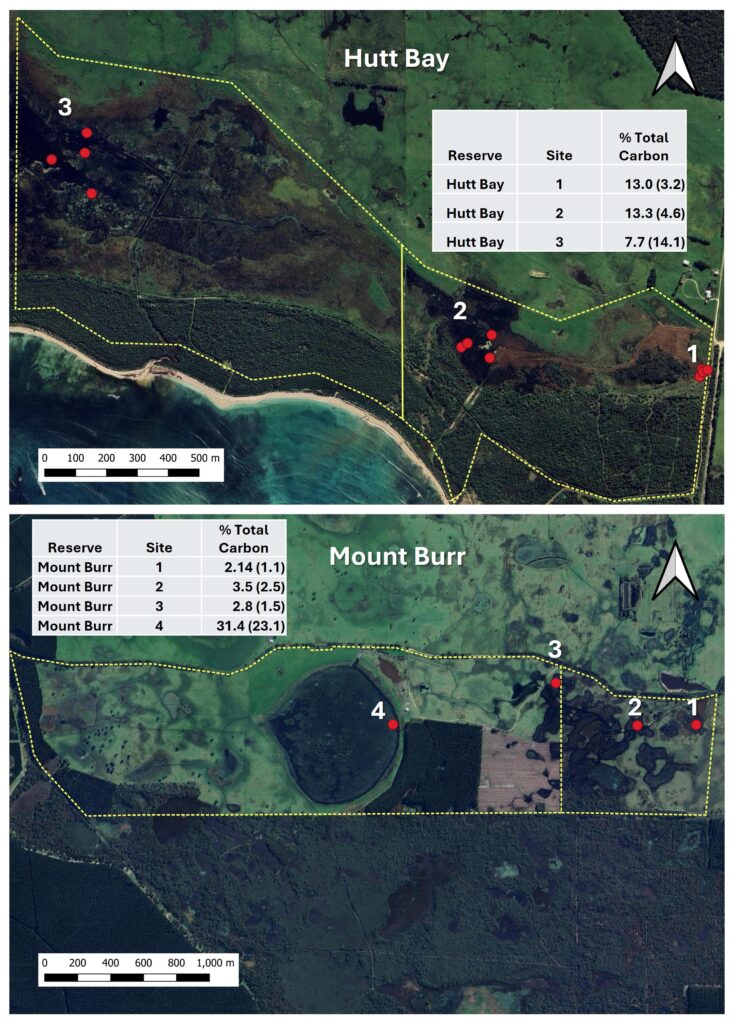Wetlands and the carbon store-y
Regular newsletter readers will know that at NGT we have an interest in understanding the complex role of wetlands in the carbon cycle. We know of course that wetlands are and will continue to be dis-proportionally impacted by changes to climate and the subsequent availability of water, but understanding how wetlands interact with carbon stores across the landscape is a big question and one that researchers and restoration practitioners are grappling with across the globe. To simplify, the carbon picture for wetlands includes two elements: 1. – Carbon storage – the organic and inorganic carbon stored in wetlands, and the tantalising prospect of locking up more carbon in wetlands through protection and restoration, and 2. – Carbon flux – the role of wetlands in the sequestration and release of Green House Gases (GHG) and how to maximise sequestration while minimising release of GHGs.
Carbon Storage
In previous editions of the newsletter we’ve explored the significant potential role of peat wetlands in carbon sequestration, and the ecological success stories around the variety of peat wetlands we’ve been working to restore across southern Australia. But what about the other types of wetlands that are common across southern Australia, where do they sit in the overall picture for carbon?
I recently rediscovered a publication from Deakin’s Blue Carbon lab in 2016, Carbon sequestration by Victorian inland wetlands by Carnell et al (2016), which quantified the carbon stocks of a diversity of different types of inland wetlands across Victoria. Inland wetlands are differentiated in carbon considerations from coastal wetlands which are tidally influenced, like coastal saltmarshes, mangroves, and near shore seagrass beds. Carbon sequestration in systems with a direct connection to the sea is relatively well understood, and is sometimes called blue carbon, whereas carbon in inland wetlands is colloquially known as teal carbon. You can read the full report below if you are interested in a deeper dive.
CarbonSequestrationByInlandVictorianWetlands_FINALIn their study, Carnell et al (2016) measured the soil carbon at 103 wetlands across Victoria, which were categorised into 5 different types of wetlands. Soil carbon was measured by taking a core using 5cm diameter PVC pipe hammered into the soil to a standard depth (1m maximum in this case). Cores were extracted and dried then assessed in the laboratory to measure the soil carbon density and results used to extrapolate the total carbon stock in each wetland. When comparing soil carbon stocks across the five wetland types sampled, Carnell et al (2106) found that permanent open freshwater wetlands had significantly lower organic carbon per hectare (just over 100 Mg/ha = 100,000 kilograms/ha) compared to shallow freshwater marshes, deep freshwater marshes and alpine peatlands.
The total amount of carbon stored in Victoria’s inland wetlands is conservatively estimated as around 68 million Mg (Mega-grams or metric tonnes) of carbon for the depth of soil sampled (maximum 1 m). The chart below shows the proportion of the total stored in each wetland type. Permanent open freshwater wetlands store the largest total volume of carbon purely by virtue of their large size. For context, it is estimated that the total combined carbon stored in Victoria’s land based parks is 270 million tonnes.
As the graph above indicates, freshwater marshes contain significant stores of wetland carbon. In fact many deep freshwater marshes that are currently or were formerly permanently inundated are also underlain by significant banks of peat soils, although the study didn’t classify them as peat wetlands. At NGT we have a particular interest in this type of wetland which is well represented across our restoration reserves, including at Mt Burr Swamp, Hutt Bay, and Green Swamp.
in 2023, to establish a carbon baseline, we did some soil carbon sampling of our Hutt Bay and Mt Burr Swamp wetlands to get a measure of the carbon stored in the wetland soils. Below is a short video of our principal ecologist (Lachlan Farrington) collecting a core sample.
The results were pretty interesting, we already knew that the wetlands of the Hutt Bay Restoration Reserve and the Mt Burr Swamp Restoration Reserve were underlain at least in part by peat soils, a relic of a long history of reliable fresh groundwater inputs driving permanent soil saturation. You can see from the figures below the results from different sampling locations, the total carbon is expressed as an average percentage of the four core samples taken at each sample site (standard deviation in brackets). Across Mt Burr, the lowest concentrations of carbon were found at the sample sites with higher sand content, and the highest within the heavily vegetated main swamp, which is underlain by deep black peat soil. Initial estimates of carbon stocks at Mt Burr, based on a 0.5 m deep core only, range from 35 TCarbon/ha to well over 200 TCarbon/ha in the top 0.5 m of soil in the main swamp. The figures would be much higher if the entire depth of the peat soils under the wetland were accounted for. At Hutt Bay figures are generally more consistent across the site with the highest measured carbon found in the more consistently inundated parts of the swamp. It is worth noting for context that the organic content of most soils are generally well under 5%. A 2022 factsheet published by the Limestone Coast Landscape Board found that the soils of the upper Limestone Coast region, for example, vary from 1.53% to 1.86% organic carbon.
The one thing that is abundantly clear from this cursory survey, is that these wetland soils store a significant volume of carbon. We are certainly keen to understand more about the carbon stored across all of our wetland restoration sites, so we will be looking for opportunities to do more thorough sampling and analysis. We are also very interested to see what happens over time as the wetland vegetation communities continue to evolve at restored sites, and what changes to soil physical and chemical properties result from the restored inundation regimes.
Carbon Flux
Carbon flux, or the balance between greenhouse gas emission and sequestration, on the other hand, is much more difficult to quantify than stable total carbon, and is also relatively poorly studied in Australia. A recent publication by Schuster et al (2024) analysed 63 global studies that quantified the greenhouse gas fluxes of 100 restored wetlands, paired with natural or degraded wetlands. Most of the study sites (93%) were in the Northern hemisphere and the vast majority were peatlands (sphagnum moss dominated). As the diagram below shows and we would expect, degraded, dry wetlands overall are net emitters of carbon dioxide (CO2), while restored wetlands sequester more carbon dioxide but also emit more methane (CH4).
Freshwater wetlands store an estimated 33% of the global terrestrial carbon pool and can do so at a rate 30-40 times higher than in a forest – due to the high rates of primary productivity in wetland vegetation and reduction in decomposition in anaerobic soils. Under the right conditions, carbon stored in wetlands can be locked up efficiently for thousands of years. Interestingly, the analysis by Schuster et al (2024) found that 74% of all restored peatlands were sequestering more carbon dioxide than they were emitting by year 5 post-restoration. They also found that, despite the negative impact of methane emissions on the overall flux equation, most restored and all natural peatlands studied were net carbon sinks.
For non-peat wetlands, carbon fluxes are even more poorly studied and understood, and yet, in Australia, they are far more common and widespread than peat wetlands. Interestingly, Schuster et al (2016) found that methane emissions from non-peat wetlands did not vary significantly between degraded, restored, and natural sites. They also highlighted the potential differences in greenhouse gas fluxes between peatlands dominated by sphagnum moss (as in the northern hemisphere) and other types of wetlands dominated by vascular plants (as are more common in Australia). They theorised that where large numbers of vascular plants are present methane emissions may be hampered by through methane oxidation, because, for example, vascular plants can transport oxygen to the root zone or because other as yet undescribed processes are at play.
A pretty interesting question when considering our vascular plant-dominated peat wetlands, like Mt Burr Swamp, below.
Unfortunately, we can’t yet measure the greenhouse gas exchange at our restored sites, as the monitoring equipment is very specialised and expensive, so we don’t have a direct baseline for greenhouse gas emissions but we are confident that the excellent research being conducted across the country will soon be available to help us understand the carbon fluxes at our sites a bit better.
I think we can all agree that restoring wetlands makes sense, not least because of the biodiversity, water storage, water quality, groundwater recharge, and landscape benefits. The carbon storage potential of wetlands over short and long timeframes is an important consideration in the global carbon balance and may be a future driver of increased wetland restoration. It’s pretty clear that protecting carbon currently stored in wetlands is a huge priority and that restoring wetlands will also produce a positive result for carbon storage over time.
For now, we’ll continue to work towards restoring wetlands whenever and wherever we can, and look forward to a day when more Australian specific research can add some more nuance to the carbon store-y.
References:
- Carnell P, Windecker S, Brenker M, Yukate B, Johnson K and Macreadie P. 2016. Carbon sequestration by Victorian inland wetlands. Blue Carbon Lab, Deakin University, Victoria, Australia.
- Lukas Schuster, Pierre Taillardat, Peter I. Macreadie, Martino E. Malerba, Freshwater wetland restoration and conservation are long-term natural climate solutions, Science of The Total Environment, Volume 922, 2024, 171218, ISSN 0048-9697, https://doi.org/10.1016/j.scitotenv.2024.171218.





